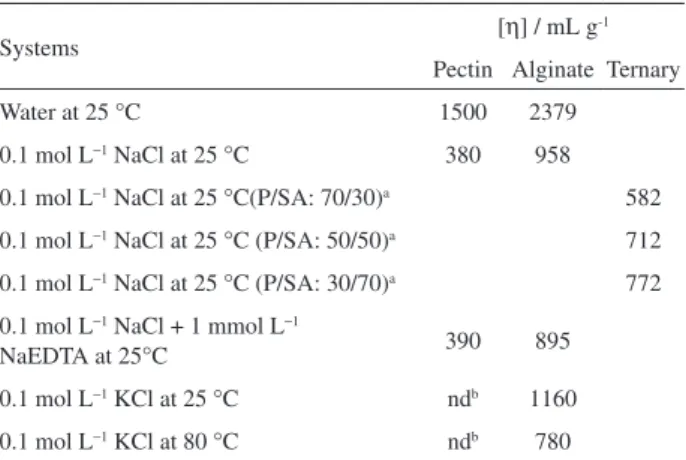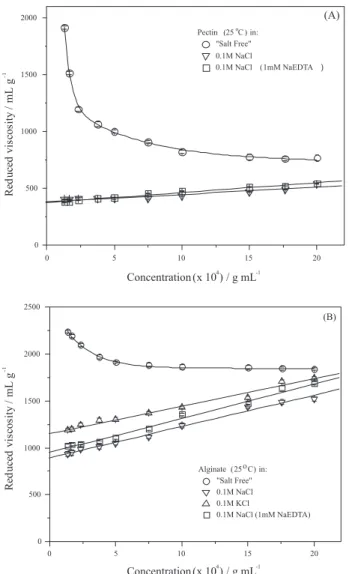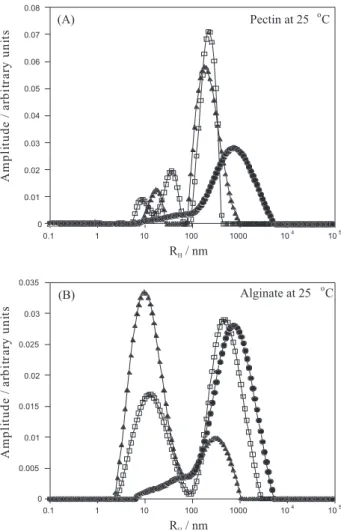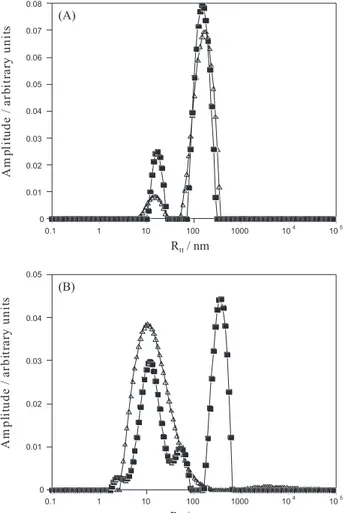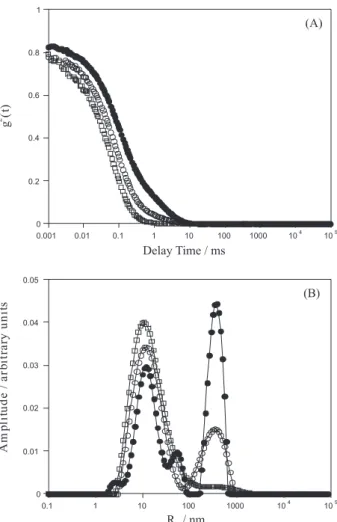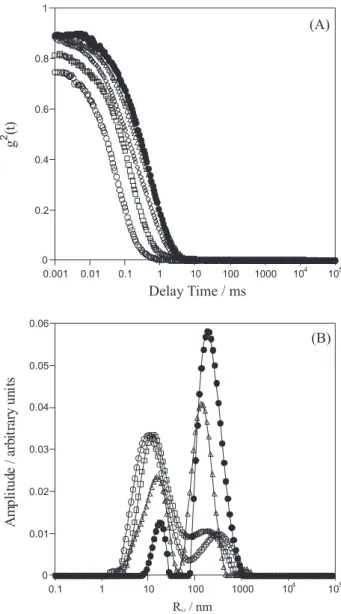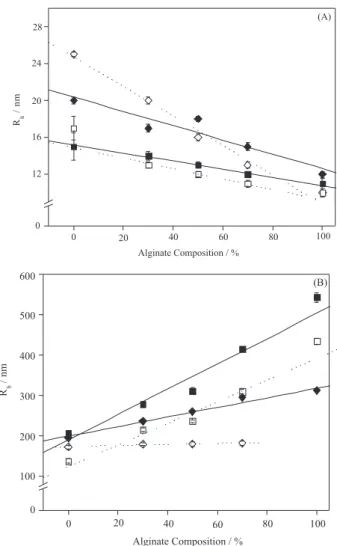Article
*e-mail: redouane.borsali@cermav.cnrs.fr, vsoldi@qmc.ufsc.br
Dynamic Light Scattering and Viscosimetry of Aqueous Solutions of Pectin, Sodium
Alginate and their Mixtures: Effects of Added Salt, Concentration, Counterions,
Temperature and Chelating Agent
Aline M. F. Lima,a Valdir Soldi*,a and Redouane Borsali*,b
aPOLIMAT - Polymeric Materials Group, Chemistry Department,
Federal University of Santa Catarina, 88040-900 Florianópolis- SC, Brazil
bCERMAV, CNRS, Joseph Fourier University BP53 38041 Grenoble, Cedex 9, France
Efeitos de adição de sal, concentração, presença de contraíons, temperatura e agente quelante em soluções aquosas de pectina, alginato de sódio e misturas destes foram analisadas por viscosimetria e espalhamento de luz dinâmico (DLS). A viscosidade intrínseca dos sistemas binários diminuiu com a adição de sal e com o aumento da temperatura, porém, mostrou-se insensível à adição de NaEDTA. Como esperado, a viscosidade intrínseca do sistema ternário alginato/pectina/água foi igual a média da viscosidade intrínseca determinada para os sistemas binários. Estudos de DLS indicaram a ocorrência de uma distribuição bimodal (presença dos modos de relaxação rápido e lento) para ambos os sistemas binários e ternários a 25 °C, reletindo um processo de agregação. No caso do modo lento de relaxação, um aumento signiicativo do raio hidrodinâmico foi observado tanto para os sistemas binários como ternário, na presença de NaCl e KCl a 25 °C. No entanto, a 80 °C, o raio hidrodinâmico correspondente ao modo lento em soluções de KCl foi praticamente constante para todos os sistemas estudados e não foi observado para o sistema binário alginato/solução aquosa.
The effects of added salt, concentration, counterions, temperature and chelating agent on aqueous solutions of pectin, sodium alginate and their mixtures were analyzed by viscosimetry and dynamic light scattering (DLS) techniques. The intrinsic viscosity of the binary systems decreased with the addition of salt and with temperature, while it was found to be insensitive to the addition of NaEDTA. As expected the intrinsic viscosity of the ternary alginate/pectin/water system was equal to the average of the intrinsic viscosity for the binary systems.The DLS studies indicated a bimodal distribution (fast and slow relaxation modes) for both binary and ternary systems at 25 °C, relecting aggregation. A signiicant increase in the hydrodynamic radius, in the case of the slow mode, was observed for the binary and ternary systems in the presence of NaCl and KCl at 25 °C. However, at 80 °C the hydrodynamic radius for the slow mode in KCl solutions was practically constant for all the studied systems, except for the alginate binary solutions inwhichwere not observed.
Keywords: pectin, sodium alginate, viscosity, salt effect, dynamic light scattering
Introduction
Sodium alginate (SA) and pectin (P) are polyelectrolytes that have been extensively studied due to their renewable and biodegradable nature. They have been used in many industrial applications, such as in packaging, coating or protective ilms for the shipping and handling of different materials,1-3 and controlled delivery of drugs.4,5 They are
also used for their pharmacological activity.6-8
Alginate is a linear polysaccharide derived from brown sea algae and is composed of (1→4)-linked β-D-mannuronate residues (M units) and (1→4)-linked α-L -guluronate (G units) in different proportions.9,10 The G and M
units are joined together in homopolymeric blocks (MM and GG) and blocks with alternate sequences (MG). Additionally, the guluronate and mannuronate residues in homopolymeric blocks present 1C
4 and 4C1 conformations, respectively. Due
to the 1C
4 conformation, the α-L-guluronate residues present
α-D-galactosyluronic acid units. Pectins are commonly classiied into two categories: high and low methoxy pectins, with a high (DM > 50%) and low (DM < 50%) degree of methoxylation, respectively.11,12
The addition of small amounts of electrolytes to polysaccharide solutions, such as alginate and pectin, reduce considerably the viscosity. On the other hand, if a large amount of salt is added, precipitation occurs.13 The
properties of alginate and pectin solutions are, in general, affected by physical and chemical parameters, such as temperature, polymer chain size, concentration, water miscible solvents, pH, monovalent salts, polyvalent cations and quaternary ammonium compounds.14,15
The viscosity of polysaccharides (polyelectrolytes) in “salt-free” solutions is known to present an abnormal behavior, that is, there is a maximum in the reduced viscosity at a certain concentration.16 It is only after
screening out the electrostatic interactions (addition of salt) that the variation in the reduced viscosity (ηr) as a function of concentration, c, becomes linear (isoionic conditions)
with the concentration (neutral behavior).17
Dynamic light scattering (DLS) studies on polyelectrolytes in the absence of salt or at low ionic strength show, in general, the existence of a bimodal time distribution behavior, corresponding to the existence of a fast and a slow relaxation mode. Such observations have been reported for different charged macromolecular systems, including synthetic18-22 and biological polyelectrolyte
solutions.23-25 The fast mode is often interpreted as a process
involving the diffusion of single polyions.26 On the other
hand, the occurrence and physical meaning of the slow mode is still not well understood, but various studies have shown that such processes or dynamics are related to the presence of aggregates or large domains in polyelectrolytes in the order of 100 nm.12,26
Although the effects of the ionic strength, salt concentration and temperature of polyelectrolyte solutions have been extensively studied for many systems using DLS and viscosimetry, the selective interaction with different mono- and divalent cations and the effect of temperature on the systems here studied are not fully understood. The aim of this work was to study the effect of added salt (different types), concentration, addition of chelating agent and temperature using viscosimetry and DLS analysis of binary (alginate/water and pectin/water) systems and their ternary mixtures (alginate/pectin/water).
Considering that the use of alginate is hindered because of its high cost, the use of pectin in the mixtures, which is widely produced in Brazil, is a potential alternative to prepare ilms for a wide range of industrial applications. Another objective is to gain a better understanding of the properties of
alginate/pectin mixtures. Such studies will give information on the percentage of pectin that can be added to the mixture without modifying the desired properties of alginate.
Experimental
Materials and methods
Sodium alginate isolated from the brown algae
Macrocystis pyrifera and citrus fruit pectin (Sigma
Aldrich Cal. Co., St. Louis, USA) were solubilized in Milli-Q water for 24 h, ultracentrifuged at 7000 rpm for 3 h, iltered through 8.0 and 0.8 μm Millipore ilters, precipitated in ethanol and dried at room temperature. The molecular weights of sodiumalginate and pectin, determined through the intrinsic viscosity [η], using the Mark-Houwinkequation (equation 1), were 375 and 83 κDa, respectively.
[η] = AMα (1)
The Mark-Houwink constant are A = 7.30 x 10−5; α = 0.92 for alginate27 and A = 9.55 x 10−5; α = 0.73
for pectin.28 The chemical composition of alginate
(corresponding to 39% guluronic (G) and 61% mannuronic (M) acids) and the degree of pectin esteriication (13%), were determined by infrared and H-NMR spectroscopies, according to Filippov29 and Gransdalen30, respectively.
“Salt-free” and 0.1 mol L−1 NaCl solutions of pectin
with and without 1 mmol L−1 NaEDTA were prepared
at room temperature. Alginate samples were dissolved in water, in 0.1 mol L−1 NaCl solution with and without
1 mmol L−1 NaEDTA at room temperature, and in
0.1 mol L−1 KCl at room temperature and 80 °C. The
mixtures were prepared by dissolving alginate and pectin in 0.1 mol L−1 NaCl solution at room temperature.
Fifteen milliliters of the sample solutions, previously iltered through a 0.22 μm membrane, were loaded into an Ubbelohde capillary. Viscosity measurements were performed using a Schott AVS 360 automatic dilution viscosimeter coupled to a Schott CT 52 water bath. The temperature and the initial pectin concentration were 25.0 ± 0.2 °C and 1 x 10−5 - 2 x 10−3 g mL-1, respectively.
The viscosimeter automatically measures the viscosity of the studied systems at different concentrations through automatic dilutions.
Alginate and pectin solutions at a concentration of 0.0018 g cm−3 were prepared in Milli-Q water containing
(0.02%) sodium azide and different salts (NaCl and KCl) at two concentrations (0.1 and 0.5 mol L−1) with
For the mixtures, stock solutions at a concentration of 0.0018 g cm−3 for pectin and alginate, in 0.1 mol L−1 KCl
and 0.1 mol L−1 NaCl, were stirred for 24 h at room
temperature. The mixtures were obtained by combining the desired amount of alginate and pectin stock solution to give the following SA/P ratios: 30/70; 50/50 and 70/30. The mixtures were left to equilibrate at room temperature and 80 °C, for 24 h, with stirring. All solutions were iltered through 0.45 and 0.22 μm ilters directly into pre-cleaned glass tubes for the DLS studies.
The scattering measurements were performed at a temperature of 25.0 ± 0.1 °C using an ALV (Langen, Germany) apparatus equipped with an automatic goniometric table and a temperature controlled sample cell. The scattering experiments were carried out at different angles ranging from 60° to 140° corresponding to a wave vector q (equation 2),
4p q
q = (–––) nsin (––) (2)
l 2
where λ is the wavelength of the incident beam in a vacuum, θ is the scattering angle and n is the refractive index (for
water, n = 1.33). The full homodyne autocorrelation
func-tion of the scattering intensity was obtained using the ALV-5000 autocorrelation provided by ALV, Langen, Germany. The measured intensity time correlation function is related to the electric ield correlation function according to the Siegert relation (equation 3),
g(2)(t) = 1 + b|g(1)(t)|2 (3)
where β is the spatial coherence factor dependent upon the geometry of the detection system and the ratio of the intensity scattered by the polymer to that scattered by the solvent. In general, g(1)(t) may be expressed by a continuous distribution of decays (equation 4).
g(1)(t) = ∫ A(Γ)exp(–Γt)dΓ (4)
The autocorrelation functions of the scattered intensity were analyzed by means of the constrained regularization (CONTIN) method developed by Provencher31 to obtain
the distribution of decay times (or frequencies) and their corresponding amplitude. The diffusion coefficients were calculated from equation 5, and the equivalent hydrodynamic radius (RH)
D = (Γ/q2)
q→0 (5)
was deduced using the Stokes-Einstein relation (equation 6), where kBT is the Boltzmann energy and f is the friction
coeficient deined by equation 7, where h0 is the solvent
viscosity.
D = k
BT/f (6)
f = 6ph0R
H (7)
Results and Discussion
Viscosimetric behavior
The reduced viscosity of linear polyelectrolytes in dilute solution is dependent on the added salt, the shape and charge of the macromolecules, the concentration, molar mass, the temperature and the counterions.32 In Figure
1, the variation in the reduced viscosity as a function of concentration for pectin (A) and sodium alginate (B) are shown. For pectin, we have reported the viscosity data in water and 0.1 mol L−1 NaCl with and without NaEDTA
(1mmol L−1 ) at 25 °C. For sodium alginate, the reported
viscosity data were taken in water and 0.1 mol L−1 NaCl
with and without NaEDTA (1 mmol L-1) and 0.1 mol L-1
KCl at 25 °C. In water, a continuous increase in viscosity with dilution was observed in both binary systems, typical of polyelectrolyte behavior, and all the data are shown in Table 1.
The semi-empirical equation of Fuoss32 has
been frequently used to determine the [η] values for polyelectrolytes in aqueous solution.33,34 In other study,
however, this method gives a very high [η] value.35 For
this reason, in this study, the [η] values obtained in pure water were itted using a fourth-order regression method, as reported by Yoo et al.36
Table 1. Viscosity data for pectin in water and 0.1 mol L−1 NaCl with and without NaEDTA (1mmol L−1) at 25 °C and for sodium alginate in water, 0.1 mol L−1 NaCl with and without NaEDTA (1mmol L−1) and 0.1 mol L−1 KCl at 25 °C and 80 °C
Systems [η] / mL g
-1
Pectin Alginate Ternary
Water at 25 °C 1500 2379
0.1 mol L−1 NaCl at 25 °C 380 958 0.1 mol L−1 NaCl at 25 °C(P/SA: 70/30)a 582 0.1 mol L−1 NaCl at 25 °C (P/SA: 50/50)a 712
0.1 mol L−1 NaCl at 25 °C (P/SA: 30/70)a 772 0.1 mol L−1 NaCl + 1 mmol L−1
NaEDTA at 25°C 390 895
0.1 mol L−1 KCl at 25 °C ndb 1160
0.1 mol L−1 KCl at 80 °C ndb 780
The addition of salt, in general, is used to screen out the electrostatic interactions.37 In the present study, NaCl
and KCl were used to extract the intrinsic viscosity data for pectin and sodium alginate. After salt addition, pectin shows a linear variation and a largedecrease in [η] (see Table 1), suggesting that the electrostatic interactions are screened out. A similar behavior (decrease in [η]) was observed for high and low methoxy pectins with salt addition.36 The addition of 1mmol L−1 NaEDTA
to the pectin or alginate solutions did not result in any signiicant change.
Our results, however, show that the increase in ionic strength (NaCl or KCl solutions), decreased the alginate viscosity and that the effect was more signiicant in NaCl than in KCl. The binding of alkali metal ions to alginate is affected by ionic electronegativity and the hydrated radius, i.e., the electrostatic repulsion along the polyion
chain decreases with increasing hydrated radius of the counterions.38 The ionic radius of Na+ is smaller than that
of K+, and Na+ is more susceptible to hydration and acts as
a structure ordering ion. A larger ion such as K+ is weakly
hydrated and is more likely to interact directly with free carboxyl groups, thereby shielding the interaction.39 In
the study of κ-carrageenan gels, Watase and Nishinari40
reported that the elastic modulus of gels increased considerably following the addition of alkali metal ions, in the order Cs+ > K+ > Na+ > Li+. In another study,36 the effect
of NaCl and LiCl addition on the [η] values was almost negligible for both high- and low-methoxy pectin solutions. For alginate, the viscosity decreased with increasing the temperature and this effect is irreversible following long term exposure to high temperatures.15 When the temperature
increases in the presence of 0.1 mol L−1 KCl the reduced
viscosity decreases suggesting that the coulombic forces and/or hydrogen bonds are disrupted at higher temperatures (in this case 80 °C) (Table 1).
It can be noted that in the case of ternary alginate/pectin solutions the intrinsic viscosity was equal to the average of the [η] for binary systems, indicating that there is no synergistic effect.
Dynamic light scattering of pectin and sodium alginate solutions
Effect of ionic strength (NaCl and KCl)
The intensity autocorrelation functions (g1 (t)) for pectin and alginate binary systems under “salt free” conditions, with 0.1 mol L−1 NaCl and with 0.1 mol L−1 KCl (after
stirring for 24 h at 25 °C) are shown in Figures 2A and 2B. The corresponding relaxation time distributions obtained from the inverse Laplace transformation of (g
1 (t)) using CONTIN showed a bimodal distribution (slow (Γs) and fast (Γf) modes), as illustrated in Figures 3A and 3B.
When the dynamical behavior is described by two relaxation modes, it is generally accepted that the fast mode (Γf) is associated with the relaxation of single molecules and that the slow mode (Γs) represents the dynamics of large interchain structures (aggregates), as previously reported for pectin systems.26,41,42 The presence of a slow mode has
been observed in many different systems including low and high ionic strength polyelectrolyte solutions,43,44 associating
polymer solutions45,46 and neutral linear polymer systems
in good and in θ solvents.47,48
The salt effect was investigated by comparing the autocorrelation functions in the presence and absence of NaCl and KCl. It is known that the elastic scattered intensity I(q) for “salt free” polyelectrolyte systems
has a maximum as a function of q. This maximum
disappears progressively when salt is added, relecting the screening of the electrostatic interactions. Such behavior has been observed in many polyelectrolytes systems, for example, in poly(styrenesulfonate)49 and
several polysaccharides,50-52 where the addition of NaCl
to the solutions screens out the electrostatic interactions. In this study, we investigated the effect of NaCl and KCl addition on the dynamics of both binary systems. Our results show that the dynamics of the alginate system is more affected by the addition of KCl than that of the pectin system. One could explain this difference by the fact that the alginate used in this study is rich in mannuronic acid (61% mannuronic), which due to the 4C
1
conformation, preferentially interacts with monovalent ions. Considering the two monovalent ions used in this study, the M blocks has a stronger preference for K+ (a
less hydrated ion with ionic radius 1.33 Å) than for Na+
(which is a highly hydrated ion with ionic radius 0.95 Å). Under such conditions, intramolecular interactions of the free guluronic groups could take place, thereby reducing the overall hydrodynamic size RH (see Table 2).
Effect of temperature
The associated hydrodynamic radius of pectin solutions were not affected by an increase in temperature from 25 °C to 80 °C (Figure 4A). Indeed, the presence of a bimodal correlation function was observed across the whole temperature range. However, one observes a slight Figure 2. Autocorrelation functions for pectin (A) and alginate (B)
solutions at 25 °C in water () with different added salts: 0.1 mol L−1 NaCl () and 0.1 mol L−1 KCl (); measurements carried out at 25 °C with a scattering angle of 90°.
Figure 3. Distribution functions of the hydrodynamic radius obtained from CONTIN method for pectin (A) and alginate (B) solutions stirring for 24 h at 25 °C in water () and different added salts: 0.1 mol L−1 NaCl () and 0.1 mol L−1 KCl (); measurements carried out at 25 °C with a scattering angle of 90°.
Table 2. Hydrodynamic radius (RH) for binary pectin and alginate solutions
in the presence of NaCl and KCl at 25 °C and 80 °C
Conditions
RH (nm)
Pectin (88 kDa) Alginate (375 kDa) Single
chain Aggregate Single
chain Aggregate 0.1 mol L−1 NaCl at 25 °C 15 187 11 543
0.1 mol L−1 NaCl at 80 °C 17 138 10 438 0.1 mol L−1 KCl at 25 °C 20 195 12 224 0.1 mol L−1 KCl at 80 °C 25 170 10 NA
decrease in the amplitude of the slow mode. On the other hand, for alginate solutions in 0.1mol L−1 KCl kept under
stirring for 24 h, at 80 °C, (Figure 4B), the slow relaxation mode vanishes, suggesting that the increase in entropy (at 80 °C) destroyed the interchain interactions involving guluronic groups. Under these conditions the guluronic groups interact more easily with the solvent molecules (water) and, consequently, only free chains are present in the systems.
In Table 2 the hydrodynamic radii (RH) for binary pectin and alginate solutions in the presence of NaCl and KCl, at 25 °C and 80 °C, are listed. As observed, the RH of the slow mode decreased with increasing temperature for both systems. The results presented here are in agreement with rheological studies carried out by Lootens et al.53 and
Gilsenan et al.54, as far as the pectin systems are concerned.
In the case of alginate, a significant decrease in RH (aggregates) was observed for KCl solutions in comparison with NaCl systems. Considering that the solvation of the
Na+ (ionic radius 0.95 Å ) is higher than that of K+ (ionic
radius 1.33 Å), a lower RH would be expected, because K+
can interact more easily with the carboxylate group than the highest solvated Na+. On the other hand, the single chain
pectin system is signiicantly affected by the temperature and the added salt. The results show that the single chain is more swollen in the case of KCl than NaCl and similar results are observed from 25 °C to 80 °C.
The effects of temperature (25 °C to 80 °C) and added salt (KCl, NaCl) do not affect the properties of the alginate single chain.
Effect of chelating agent (NaEDTA)
In order to better understand the formation of aggregates in salt solutions of pectin and alginate, different concentrations of the chelating agent NaEDTA were added to solutions of pectin and alginate in 0.1 mol L−1and
0.5 mol L−1 NaCl. The hydrodynamic radius associated
with the fast relaxation mode (single chain) varied with increasing NaEDTA concentration for both systems in 0.1 mol L−1 and 0.5 mol L−1 NaCl (Figure 5), whereas, for
the slow relaxation mode the RH increased in the case of pectin at both NaCl concentrations. The chelating effect of NaEDTA is associated with the substitution of Na+ by
traces of ions which can participate in the screening out of the interactions between the galacturonic groups. An increase in the NaEDTA in NaCl solutions, increases the probability for the formation of multi-chain associations, and this effect is more pronounced in 0.5 mol L−1 NaCl. As
the NaCl concentration increases, the system favors the multi-chain associations by polar bonded complexes, and, as a consequence, the RH values for both modes increase. For alginate solutions at 0.1 mol L−1 and 0.5 mol L−1 NaCl,
the addition of NaEDTA decreased slightly the RH value for the slow mode up to 1 mmol L−1, this value remaining
constant at higher NaEDTA concentrations. The observed result (a decrease in RH) is associated with the interactions between NaEDTA and traces of ions present in solution, which decrease the aggregation between chains. The RH values for the two systems in 0.1 mol L−1 NaCl, determined
at 25 °C and 80 °C, were, within experimental errors, practically the same.
The dynamical behavior of pectin at 80 °C was similar to that observed at 25 °C. However, a slight difference was observed in the case of alginate.
In fact, at 80 °C (Figure 6A), one observes that the relaxation time decreased with an increase in NaEDTA concentration, and at 5 mmol L−1 of NaEDTA the aggregates
were progressively destroyed (Figure 6B). This result suggests that the aggregates are formed in the presence of traces of ions in the case of alginate. At the same time, on raising the Figure 4. Distribution function of the hydrodynamic radius obtained from
temperature in an excess of NaEDTA, the dynamics is mainly described by the fast relaxation time (single alginate chain) and a small contribution to the low frequency.
Dynamic light scattering of ternary pectin and alginate mixtures
Figure 7 shows the autocorrelation functions measured for ternary alginate/pectin mixtures in comparison with the binary systems, in KCl, after stirring for 24 h at 25 °C. Similar studies were conducted in the presence of NaCl and the observed behavior in the case of KCl was reproducible. The results show that all the correlation functions are described by two relaxation modes for all the studied compositions (A/P: 0/100, 30/70, 50/50, 70/30, 100/0). The corresponding relaxation time distribution is shown in Figure 7B.The two modes observed for the mixtures at the
two salt concentrations and at 25 °C were extracted from CONTIN analysis and are listed in Tables 3 and 4. The results show that in NaCl and KCl media the correlation function is represented by two relaxation modes, except for the case of sodium alginate in KCl. In NaCl, the slow (Γs ) and fast (Γf ) modes predominated in mixtures with high and low pectin content, respectively.
Figure 5. Hydrodynamic radius versus NaEDTA concentration stirring
for 24 h at 25 °C for pectin (A) and alginate (B) in: 0.1 mol L−1 NaCl for () fast and () slow relaxation modes; 0.5 mol L−1 NaCl for () fast and () slow relaxation modes. Measurements carried out at 25 °C with a scattering angle of 90°. The solid and dotted lines represent the free chains and aggregates, respectively.
Figure 6. (A) g2 (t) versus delay time (ms) and (B) amplitude versus R H for sodium alginate stirring for 24 h in 0.1 mol L−1 NaCl at 80 °C with different NaEDTA concentrations () 0 mmol L−1 ; ()1 mmol L−1 and () 5mmol L−1 ; measurements carried out at 25 °C with a scattering angle of 90°.
Table 3. Hydrodynamic radius for the fast and slow relaxation modes of pectin/alginate systems in 0.1 mol L−1 NaCl at 25 °C and 80 °C
Pectin/Alginate 0.1 mol L−1 NaCl at 25 °C
0.1 mol L−1 NaCl at 80°C
systems RH1 RH2 RH1 RH2
Table 4. Hydrodynamic radius for the fast and slow relaxation modes of
pectin/alginate systems in 0.1 mol L−1 KCl at 25 °C and 80 °C
Pectin/ Alginate system
0.1 mol L−1 KCl at 25 °C
0.1 mol L−1 KCl at 80 °C
RH1 RH2 RH1 RH2
100/0 20.0 ± 0.3 196.2 ± 4.2 24.9 ± 0.3 172.8 ± 5.2 70/30 16.9 ± 0.4 237.8 ± 4.7 20.0 ± 0.4 178.2 ± 3.4 50/50 18.1 ± 0.3 261.2 ± 5.7 15.9 ± 0.3 179.9 ± 5.4
30/70 15.0 ± 0.4 295.6 ± 6.2 12.9 ± 0.4 181.6 ± 5.2 0/100 11.9 ± 0.3 313.0 ± 4.1 10.0 ± 0.5 NA
RH1 and RH2 correspond to the fast and slow relaxation modes, respectively. NA: No aggregation
Figure 7. (A) Autocorrelation functions for alginate (), pectin () and their mixtures A/P 30/70 (), A/P 50/50 () and A/P 70/30 () in KCl solution stirring for 24 h at 25 °C; measurements carried out at 25 °C with a scattering angle of 90°. (B) Distribution functions of the hydrodynamic radius obtained from CONTIN analysis for alginate (), pectin () and their mixtures SA/P 30/70 () and SA/P 70/30 () stirring for 24 h at 25 °C in KCl; measurements carried out at 25 °C with a scattering angle of 90°.
Mixtures of two polysaccharides have been, in general, analyzed considering the properties of both binary systems.55-58 Interactions between the two components
in mixtures can lead to a microstructure totally different from that of the pure polymers, and therefore improve the mechanical and rheological properties. Such effects have been reported, for example, in systems of polygalactans, galactose and glucomannas, as well as xanthan and galacto- and glucomannans.59 However, for sodium caseinate-xanthan
systems it has been reported that the mixtures corresponded to the superposition of the modes of the pure biopolymers, suggesting the absence of interactions between the components in the concentration range studied.60
In this study, the sodium alginate/pectin system showed an increase in RH after stirring the solutions for 24 h at 25 °C and 80 °C, in either NaCl or KCl. A similar effect has been observed by Hiorth et al.12 for chitosan and high pectin
content solutions. The authors suggested the formation of large association complexes due to the hydrogen bonds formed between chitosan and pectin.
Figure 8A shows the fast mode hydrodynamic radius versus alginate composition for sodium alginate/pectin systems at different salt concentrations and temperatures. Without heating the polymer solutions, the RH for the mixtures and pure polymers showed a similar behavior, which was dependent on the volume fraction in either salt, although the RH is slightly higher in KCl than in NaCl. However, at high temperatures an abrupt decrease in the RH values was observed in KCl solutions. The values for RH in NaCl solutions were all higher when stirred at 25 °C than at 80 °C, except for pure pectin and SA/P 30/70, due to a higher swelling degree of the pectin chain. The same behavior was observed for RH in 0.1 mol L−1 KCl. The
observed behavior is in total agreement with the binary solutions of alginate and pectin, as previously explained.
The hydrodynamic radiusof the slow mode (Figure 8B) for the solution prepared at 25 °C increased with the alginate volume fraction in the mixtures and showed higher values in NaCl than in KCl. A similar behavior was observed at 80 °C, however, in KCl solutions the RH remained constant for all the volume fractions due to the absence of alginate aggregates at this temperature.
Conclusions
Figure 8. Hydrodynamic radius versus alginate composition for different salts and temperatures, for fast mode (A) and slow mode (B): 0.1 mol L−1 NaCl at 25 °C (); 0.1 mol L−1 KCl at 25 °C (); 0.1 mol L−1 NaCl at 80 °C () and 0.1 mol L−1 KCl at 80 °C ().
did not lead to any signiicant change in the intrinsic viscosity. In the case of ternary systems, the experimental value for the intrinsic viscosity was equal to the average of the intrinsic viscosity for binary systems, indicating that there is no synergistic effect.
The DLS studies indicated a bimodal distribution (fast and slow relaxation modes) for binary systems of alginate and pectin in the absence of salt and in the presence of NaCl and KCl, at 25 °C. On increasing the temperature to 80 °C, the slow relaxation mode for the alginate system in KCl disappeared, suggesting that the interactions between adjacent guluronic groups in the chain are screened out. The hydrodynamic radius corresponding to the slow mode for binary pectin and alginate systems in the presence of NaCl and KCl decreased with the increase in temperature. In the case of alginate, the effect was more signiicant in KCl than in NaCl solutions. With the addition of NaEDTA, an effect (increase in RH for the slow mode) was observed in the case of the pectin system only.
For the ternary systems, the RH for the fast mode decreased with an increase in alginate content for the two salts and temperatures. The opposite behavior (increase in RH) was observed for the slow mode in the ternary systems in NaCl solutions at 25 °C and 80 °C. In KCl, the RH values for the slow mode increased at 25 °C, and remained practically constant at 80 °C. The RH values for the slow mode were lower in KCl than NaCl solutions.
Acknowledgements
The authors gratefully acknowledge CAPES-Brazil (CAPES/COFECUB-348/1 and 620/08) and Federal University of Santa Catarina (UFSC) for the inancial support. A part of this work was carried out at LCPO-Université Bordeaux I.
References
1. Rhim, J. W.; Wu, Y.; Weller, C. L.; Schnepf, M.; J. Food Sci.
1999, 64, 149.
2. Rhim, J. W.; Lee, J. H.; Hong, S. I.; LWT-Food Sci. Technol.
2006, 39, 806.
3. Maftoonazad, N.; Ramaswamy, H. S.; Marcotte, M.; J. Food Process Eng. 2007, 30, 539.
4. Gilchrist, T.; Martin, A. M.; Biomaterials 1983, 4, 317. 5. Liu, L. S.; Finkenstadt, V. L.; Liu, C. K.; Jin, T.; Fishman, M.
L.; Hicks, K. B.; J. Appl. Polym. Sci. 2007, 106, 801. 6. Ashford, M.; Fell, J.; Attwood, D.; Sharma, H.; Woodhead, P.;
J. Controlled Release 1993, 26, 213.
7. Rubinstein, A.; Radai, R.; Ezra, M.; Pathak, S.; Rokem, J. S.; Pharm. Res. 1993, 10, 258.
8. Ashford, M.; Fell, J.; Attwood, D.; Sharma, H.; Woodhead, P.; J. Controlled Release 1994, 30, 225.
9. Smidsrod, O.; Skjakbraek, G.; Trends Biotechnol. 1990, 8, 71. 10. Johnson, F. A. ; Craig, D. Q. M. ; Mercer, A. D. ; J. Pharm.
Pharmacol. 1997, 49, 639.
11. Kjoniksen, A. L.; Hiorth, M.; Nystrom, B.; Eur. Polym. J. 2004,
40, 2427.
12. Hiorth, M.; Kjoniksen, A. L.; Knudsen, K. D.; Sande, S. A.; Nystrom, B.; Eur. Polym. J. 2005, 41, 1718.
13. Haug, A.; Acta Chem. Scand. 1959, 13, 1250.
14. Walter, R. H.; The Chemsitry and Technology of Pectin, Academic Press, Berlin, Germany, 1991.
15. Day, D. F. Alginates. In Biopolymers from Renewable Resources. Kaplan, D. L.; Springer, San Diego, USA, 1998.
16. Fuoss, R. M.; J. Polym. Sci. 1949, 4, 96.
17. Eisenberg, H.; Pouyet, J.; J. Polym. Sci. 1954, 13, 85. 18. Koene, R. S.; Mandel, M.; Macromolecules 1983, 16, 973. 19. Sedlak, M.; Konak, C.; Stepanek, P.; Jakes, J.; Polymer 1987,
20. Schmitz, K. S.; Yu, J. W.; Macromolecules 1988, 21, 484. 21. Ermi, B. D. ; Amis, E. J. ; Macromolecules 1996, 29, 2701. 22. Topp, A.; Belkoura, L.; Woermann, D.; Macromolecules 1996,
29, 5392.
23. Lin, S. C.; Lee, W. I.; Schurr, J. M.; Biopolymers 1978, 17, 1041.
24. Mathiez, P.; Mouttet, C.; Weisbuch, G.; Biopolymers 1981, 20, 2381.
25. Borsali, R.; Nguyen, H.; Pecora, R.; Macromolecules 1998, 31, 1548.
26. Tanahatoe, J. J.; Kuil, M. E.; J. Phys. Chem. B 1997, 101, 9233. 27. Martinsen, A.; Skjakbraek, G.; Smidsrod, O.; Zanetti, F.;
Paoletti, S.; Carbohydr. Polym. 1991, 15, 171. 28. Anger, H.; Berth, G.; Carbohydr. Polym. 1986, 6, 193. 29. Filippov, M. P.; Kohn, R.; Chem. Zvesti 1974, 28, 817. 30. Grasdalen, H.; Bakoy, O. E.; Larsen, B.; Carbohydr. Res. 1988,
184, 183.
31. Provencher, S. W.; Comput. Phys. Commun. 1982, 27, 213. 32. Morawetz, H.; Macromolecules in Solution, Wiley: New York,
1975.
33. Yuan, L.; Stivala, S. S.; Doughert.T. J.; J. Polym. Sci. Part A.
1972, 10, 171.
34. Cooper, E. C.; Johnson, P.; Donald, A. M.; Macromolecules
1991, 24, 5380.
35. Michel, F.; Thibault, J. F.; Doublier, J. L.; Carbohydr. Polym.
1984, 4, 283.
36. Yoo, S. H.; Fishman, M. L.; Hotchkiss, A. T.; Lee, H. G.; Food Hydrocolloids 2006, 20, 62.
37. Smidsrød, O.; Haug, A.; Biopolymers 1971, 10, 1213. 38. Zhang, H. C.; Zheng, H. H.; Zhang, Q. Z.; Wang, J. J.; Konno,
M.; Biopolymers 1998, 46, 395.
39. Miyata, K.; Kanno, H.; Niino, T.; Tomizawa, K.; Chem. Phys. Lett. 2002, 354, 51.
40. Watase, M.; Nishinari, K.; J. Texture Stud. 1981, 12, 427. 41. Bulone, D.; Martorana, V.; Xiao, C. D.; San Biagio, P. L.;
Macromolecules 2002, 35, 8147.
42. Narayanan, J.; Deotare, V. W.; Bandyopadhyay, R.; Sood, A. K.; J. Colloid Interface Sci. 2002, 245, 267.
43. Reed, W. F.; Macromolecules 1994, 27, 873.
44. Ermi, B. D.,Amis, E. J. ; Macromolecules 1998, 31, 7378. 45. Klucker, R.; Munch, J. P.; Schosseler, F.; Macromolecules 1997,
30, 3839.
46. Esquenet, C.; Buhler, E.; Macromolecules 2001, 34, 5287. 47. Adam, M., Delsanti, M.; Macromolecules 1985, 18, 1760. 48. Buhler, E.; Munch, J. P.; Candan, S. J.; J. Phys. II 1995, 5, 765. 49. Drifford, M.; Dalbiez, J. P.; Biopolymers 1985, 24, 1501. 50. Morin, I.; Reed, W. F.; Rinaudo, M.; Borsali, R.; J. Phys. II
1994, 4, 1001.
51. Borsali, R.; Rinaudo, M.; Noirez, L. Macromolecules 1995, 28, 1085.
52. Milas, M.; Rinaudo, M.; Duplessix, R.; Borsali, R.; Lindner, P.; Macromolecules 1995, 28, 3119.
53. Lootens, D. ; Capel, F. ; Durand, D. ; Nicolai, T. ; Boulenguer, P. ; Langendorff, V. ; Food Hydrocolloids 2003, 17, 237. 54. Gilsenan, P. M.; Richardson, R. K.; Morris, E. R.; Carbohydr.
Polym. 2000, 41, 339.
55. Bergfeldt, K.; Piculell, L.; Linse, P.; J. Phys. Chem. 1996, 100, 3680.
56. Picout, D. R.; Richardson, R. K.; Morris, E. R.; Carbohydr. Polym. 2000, 43, 133.
57. Picout, D. R.; Richardson, R. K.; Rolin, C.; Abeysekera, R. M.; Morris, E. R.; Carbohydr. Polym. 2000, 43, 113.
58. Gilsenan, P. M.; Richardson, R. K.; Morris, E. R.; Food Hydrocolloids 2003, 17, 751.
59. Willians, P. A.; Phillips, G.O.; Interactions in Mixed Polysaccharide Systems. In Food Polysaccharides and Their Applications. Stephen, A. M., Marcel Dekker, New York, USA, 1995, p.463.
60. Nash, W.; Pinder, D. N.; Hemar, Y.; Singh, H.; Int. J. Biol. Macromol. 2002, 30, 269.
Received: December 22, 2008
